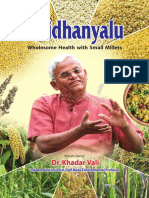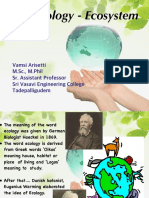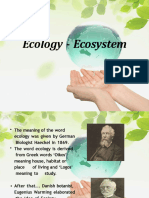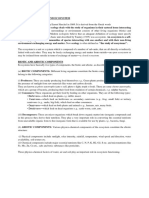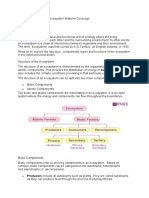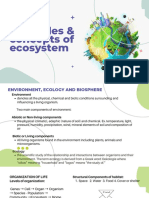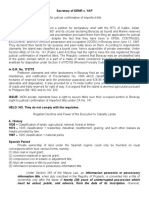0 ratings0% found this document useful (0 votes)
27 viewsEcology & Ecosystem
Ecology & Ecosystem
Uploaded by
JackThe document discusses key concepts in ecology including organisms, populations, communities, ecosystems, biomes, and the biosphere. It also describes the biotic and abiotic components of ecosystems, trophic levels, food chains, food webs, and ecological pyramids.
Copyright:
© All Rights Reserved
Available Formats
Download as PDF, TXT or read online from Scribd
Ecology & Ecosystem
Ecology & Ecosystem
Uploaded by
Jack0 ratings0% found this document useful (0 votes)
27 views7 pagesThe document discusses key concepts in ecology including organisms, populations, communities, ecosystems, biomes, and the biosphere. It also describes the biotic and abiotic components of ecosystems, trophic levels, food chains, food webs, and ecological pyramids.
Original Description:
Ecology and ecosystem Bba bcom pass couree
Copyright
© © All Rights Reserved
Available Formats
PDF, TXT or read online from Scribd
Share this document
Did you find this document useful?
Is this content inappropriate?
The document discusses key concepts in ecology including organisms, populations, communities, ecosystems, biomes, and the biosphere. It also describes the biotic and abiotic components of ecosystems, trophic levels, food chains, food webs, and ecological pyramids.
Copyright:
© All Rights Reserved
Available Formats
Download as PDF, TXT or read online from Scribd
Download as pdf or txt
0 ratings0% found this document useful (0 votes)
27 views7 pagesEcology & Ecosystem
Ecology & Ecosystem
Uploaded by
JackThe document discusses key concepts in ecology including organisms, populations, communities, ecosystems, biomes, and the biosphere. It also describes the biotic and abiotic components of ecosystems, trophic levels, food chains, food webs, and ecological pyramids.
Copyright:
© All Rights Reserved
Available Formats
Download as PDF, TXT or read online from Scribd
Download as pdf or txt
You are on page 1of 7
Ecology and Ecosystem
Organism- Any living being is called an organism.
Spices- Species is a group of similar organisms.
Population- Population is a group of individual members of the same species
living in a given area at the same time. for example, frogs in a pond.
Community- A community consists of populations of different species (plants,
animals, microorganisms) living and interecting in a given area at a given time.
Ecosystem- One or more communities of different species interacting with one
another and with their non-living environment. example pond ecosystem,
grassland ecosystem. The word ecosystem was first used by A.G. Tansley in
1935.
Biome- A biome is a Terrestrial and regional ecosystem with a distinct climate
and distinct biological community of plants, animals and other organisms. for
example, forest, desert.
Biosphere-The biosphere is the part of Earth where life exists and it includes
the atmosphere, Hydrosphere, lithosphere.
Structure of an ecosystem- An ecosystem consisting of two main components
abiotic (non-living) and biotic(living) components. A biotic part of an ecosystem
consists of the living organisms that are the plants, the animals and
microorganisms. The abiotic parts of an ecosystem consisting of all the
conditions under which the organisms live.
Ecology - The scientific Study of the interactions between organisms and their
environment is known as an ecology. The word Ecology was used first time by
the German biologist Ernst Haeckel in 1869. The word Ecology was derived
from the Greek word “oikos” meaning ‘House’ and “logos” meaning “study of”.
Food chain- Food chain is a sequence of organisms in which each one prays on
the preceding one. The food chain shows the Predator prey relationship.
Example- grass- grasshopper- frog- snake- Hawk
There are two types of food chain-
i) Grazing food chain- When the food chain starts from Green plant base goes
to grazing herbivores and on to carnivores , is the grazing food chain. The
grazing food chain will be illustrated as
Autotrophs - herbivore - primary carnivore- secondary carnivore.
ii) Detritus food chain- This food chain starts from dead organic matter and
goes to microorganisms and then to detrivores.
The biotic components of an ecosystem is classified as follows-
i) Autotrophs- This category includes all those organisms, green plants,
bacteria and algae which are capable of converting solar energy into chemical
energy and storing food stuff in the presence of carbon dioxide and water.
ii) Heterotrophs or consumers- All other organisms are consumers which
cannot convert Solar energy into food.
Depending upon the following habit heterotrophs are classified
as follows-
a) Primary consumer- Organism or animals which feed on green plants(
autotrophs) to obtain energy for survival are the primary consumers. They are
also known as the Herbivores. Example- cow, goats, Mouse rabbits insect etc.
b) Secondary consumer- Animals which feed on herbivores are known as
secondary consumers. Example- frog, lizards etc. they are also known as
carnivores.
c) Tertiary consumers- They eat secondary consumers. Example- eagle. They
are also known as carnivorous or top carnivorous.
iii)Decomposers- A decomposer is an organism that digest and breakdown
dead organisms and wastes of living organisms. Decomposers are mainly
bacteria and fungi. Decomposers are also called micro consumer.
Detrivore - A detrivore eats detritus which consists of organic litter, debris and
dung. For example- flies, cockroaches, earthworms, wood beetles, carpenter
ants.
Trophic level- The trophic level of an organism is its position in the food chain.
Food web-In an ecosystem various food chains are linked together and
intersect each other to form a complex network called food web.
Ecological pyramid- Ecological pyramids are the graphical representation of
the number, Biomass and energy of the successive trophic level of an
ecosystem. Charles Eilton(1927) was first described the ecological pyramid.
There are three types of ecological pyramids
i) Pyramid of number -It shows total number of individuals at each tropic
level.It maybe upright or inverted.
ii ) Pyramid of biomass- It shows dry Total weight of matter at any time in the
ecosystem. It may be upright or inverted.
iii) Pyramid of energy- The herbivores eat producer as their food and same
way the primary consumers eat the herbivores and secondary consumers take
primary consumer as their food and the tertiary consumer eat secondary
consumer as their food. So, each and every successive level the energy transfer
only 10% and the rest 90% energy is loss. The pyramid of energy is always
upright as it shows loss of energy at every trophic level of food chain.
Ecological succession- according to the concept of evolution species never
found in permanent form but they keep on changing over a period of time due
to variation in climatic and physiographic factor and by inter specific activities.
This is called ecological succession.
Biogeochemical cycle- In a self-sufficient ecosystem, there occurs the flow of
minerals (C, N, O2, S, P) and energy through the abiotic and biotic components
of the ecosystem. Cyclical path of the elements from the abiotic system to the
biotic system and back is called biogeochemical cycle.
There are three types of biogeochemical cycle. these are-
i) Hydrological cycle (water cycle).
ii) Gaseous cycles (carbon, nitrogen and oxygen cycle).
iii) Sedimentary cycles (Phosphorus and sulphur cycle).
The Carbon cycle :
The Water cycle :
The Oxygen cycle:
THE DESCRIPTION OF A GRASS LAND ECOSYSTEM
The grass land ecosystem is a terrestrial ecosystem. In a grass land ecosystem,
there present various components. These are as follows-
Biotic components-
Producer- different types of grass species namely-Cynodon, Desmodium,
Brachiaria etc , few shrubs and a very few number of trees are present.
Consumer-Primary consumer- herbivores like cow, deer, goat, sheep,
buffaloes, rabbit, mouse etc are found.
Secondary consumer- it includes fox, hyena, snake, lizard, small birds etc.
Tertiary consumer- it includes owl, kites, hawk etc.animals.
Abiotic components- it includes sunlight, air, water, soil, rain, humidity,
temperature, soil nutrients etc.
Decomposers- the bacteria and fungi are the decomposers.
THE DESCRIPTION OF A FOREST ECOSYSTEM
The forest is an ecosystem dominated by trees and woody vegetation. The
components of a forest ecosystem is as follows-
Abiotic components- it includes sunlight, air, water, soil, rain, humidity,
temperature, soil nutrients, organic matter etc.
Biotic components-
Producer- in tropical moist forest different types of trees species present
namely- Tectona grandis, Shorea sp., Butea sp. etc. In temperate deciduous
forest trees like Acer, Thuja, Betula, Picea species are dominantly found and in
temperate coniferous forest there mainly found Abis,Picea,Pinus, Oak,
Rhododendron etc.
Consumer-
Primary consumer- different types of insects, flies, ants, mouse, spider etc are
found. The grazing herbivores like deer, elephant, rabbit, squirrel, monkey etc
are found.
Secondary consumer- it includes fox, hyena, snake, lizard, small birds etc.
Tertiary consumer- it includes tiger, lion, owl, kites, hawk etc. animals.
Decomposers- the bacteria and fungi are the decomposers.
You might also like
- Siridhanya-English - DR Khader ValiDocument84 pagesSiridhanya-English - DR Khader ValiAnanth Kumar91% (43)
- Ecology Notes!!Document10 pagesEcology Notes!!Raudha Athif100% (3)
- DipterocarpaceaeDocument23 pagesDipterocarpaceaecindy_lee_11No ratings yet
- Ecosystem PDFDocument32 pagesEcosystem PDFYuvashreeNo ratings yet
- Unit - III: Abiotic Components Biotic Components Physical Factors Inorganic Substances Organic SubstancesDocument12 pagesUnit - III: Abiotic Components Biotic Components Physical Factors Inorganic Substances Organic SubstancesinayatNo ratings yet
- Unit 2 EcosystemDocument91 pagesUnit 2 EcosystemJane AlamNo ratings yet
- Ecosystem PPT 735Document100 pagesEcosystem PPT 735Pauldavid SelsonNo ratings yet
- Ecosystem New 2017Document20 pagesEcosystem New 2017raniNo ratings yet
- Module - III-Ecosystem NotesDocument100 pagesModule - III-Ecosystem Notesdellaishere03No ratings yet
- Ecosystem RevisedDocument100 pagesEcosystem RevisedAlonafe TevesNo ratings yet
- Ecosystems and BiodiversityDocument25 pagesEcosystems and BiodiversityRahul67% (3)
- Ecology - BSC (H) Botany - IV SemesterDocument6 pagesEcology - BSC (H) Botany - IV Semestervishnu tyagiNo ratings yet
- Environmental DisatersDocument300 pagesEnvironmental DisatersFaith RiderNo ratings yet
- Ecology EcosystemDocument70 pagesEcology Ecosystemshan.forstudiesNo ratings yet
- Ecosyste 1Document8 pagesEcosyste 1mugishablessoceaneNo ratings yet
- 2 EcosystemsDocument68 pages2 EcosystemsSanjana SNo ratings yet
- Chapter 3.ecosystemDocument44 pagesChapter 3.ecosystemRupesh BavgeNo ratings yet
- Definition of Terms 1: EcologyDocument17 pagesDefinition of Terms 1: EcologyPallavi Dalal-WaghmareNo ratings yet
- 10 - CH 15 Our Environment Study MaterialDocument16 pages10 - CH 15 Our Environment Study MaterialMoksha ShahNo ratings yet
- Evs NotesDocument36 pagesEvs NotesPUSHPA RAAJNo ratings yet
- Class 2 Unit 2 EcosystemDocument57 pagesClass 2 Unit 2 Ecosystemsinghalmanvi004No ratings yet
- Lecture Notes - Evs Unit - 3Document20 pagesLecture Notes - Evs Unit - 3Nambi Rajan100% (1)
- Our Environment Notes 1Document9 pagesOur Environment Notes 1Kanishka ChauhanNo ratings yet
- Ecosystem NotesDocument11 pagesEcosystem Notesluciferx187No ratings yet
- AEC UNIT 2 Ecosystem NotesDocument10 pagesAEC UNIT 2 Ecosystem Notescharusengar31No ratings yet
- First and Second Lectures of EcosystemDocument23 pagesFirst and Second Lectures of EcosystemAya DawoodNo ratings yet
- EcosystemDocument5 pagesEcosystemRaine CuenarNo ratings yet
- EcosystemDocument10 pagesEcosystemAšïm JĂñ ĀlbalosHiNo ratings yet
- EcologyDocument18 pagesEcologyharshbaghel8349No ratings yet
- Principles and Concept of EcosystemDocument16 pagesPrinciples and Concept of EcosystemJay Bianca Abera Alistado100% (1)
- EcosystemDocument8 pagesEcosystemArts NEFNo ratings yet
- Unit 2: Ecosystems: Ecology & EcosystemDocument21 pagesUnit 2: Ecosystems: Ecology & EcosystemDEVILNo ratings yet
- Concept of Ecology and EcosystemDocument5 pagesConcept of Ecology and EcosystemDhanunjayaNo ratings yet
- A Seminar On The: EcosystemDocument28 pagesA Seminar On The: Ecosystemjohn sharmaNo ratings yet
- Bot Unit V Plant Ecology NotesDocument15 pagesBot Unit V Plant Ecology NotesBirhanu GebeyehuNo ratings yet
- Ecology and Ecosystem.. AnnotedDocument35 pagesEcology and Ecosystem.. AnnotedSubhadip BNo ratings yet
- GE6351 Environmental Science and EngineeringDocument261 pagesGE6351 Environmental Science and EngineeringAkshay UdayNo ratings yet
- Unit IIDocument58 pagesUnit IIhamzanadeem7896No ratings yet
- Es - 3 - 1Document81 pagesEs - 3 - 1mukundapriya1981No ratings yet
- Concept of An EcosystemDocument6 pagesConcept of An EcosystemMrigendra MishraNo ratings yet
- Est MicroprojectDocument8 pagesEst Microprojectjayeshbaviskar9501No ratings yet
- People and The Earths Ecosystem CoverageDocument49 pagesPeople and The Earths Ecosystem CoverageChristen Honely DadangNo ratings yet
- Our Environment: Chapter - 15Document10 pagesOur Environment: Chapter - 15IshvaryaNo ratings yet
- Ecosystem and Biodiversity: (A) (B) (C) (D)Document9 pagesEcosystem and Biodiversity: (A) (B) (C) (D)Raquel MañacapNo ratings yet
- EcosystemDocument8 pagesEcosystemKhushi SalgaonkarNo ratings yet
- Food ChainDocument5 pagesFood ChainAnanthCJayanNo ratings yet
- Module 1 EcosystemDocument8 pagesModule 1 EcosystemVidhyashree YadavNo ratings yet
- Ecology Ernst Haeckel in 1869: Species Living Together in The Same Area Ex. Human Population. in TurnDocument10 pagesEcology Ernst Haeckel in 1869: Species Living Together in The Same Area Ex. Human Population. in TurnJo-ann SuyatNo ratings yet
- EVS Module No - 2 Ecosystem New 2023Document11 pagesEVS Module No - 2 Ecosystem New 2023prakashnisha9741No ratings yet
- Lesson 3 Students Hand-OutDocument6 pagesLesson 3 Students Hand-OutMarygrace SanopalNo ratings yet
- EcosystemDocument20 pagesEcosystemFaraz NaqviNo ratings yet
- GEL 2 (Task2) MidtermDocument6 pagesGEL 2 (Task2) MidtermBethwen Eliza CDichosoNo ratings yet
- Environment IDocument14 pagesEnvironment I9921005047No ratings yet
- Chapter 2 EcosystemDocument6 pagesChapter 2 EcosystemNitish BarmanNo ratings yet
- EcosystemDocument50 pagesEcosystemzainhaadee288No ratings yet
- ECOSYSTEMDocument3 pagesECOSYSTEMcathleenborre0923No ratings yet
- Unit 1Document88 pagesUnit 1nikki123456790No ratings yet
- ENVIRONMENT-unit 1Document27 pagesENVIRONMENT-unit 1Bhoomi UpadhyayNo ratings yet
- Ecosystem ReportDocument27 pagesEcosystem ReportJay Bianca Abera AlistadoNo ratings yet
- Our Environment (Prashant Kirad)Document10 pagesOur Environment (Prashant Kirad)abupendari75% (8)
- How Does the Food Chain Work? - Science Book for Kids 9-12 | Children's Science & Nature BooksFrom EverandHow Does the Food Chain Work? - Science Book for Kids 9-12 | Children's Science & Nature BooksNo ratings yet
- Fine-Scale - Topography ALICEDocument10 pagesFine-Scale - Topography ALICEluz marina mulato campoNo ratings yet
- Wood Densities of Tropical Tree SpeciesDocument21 pagesWood Densities of Tropical Tree SpeciesBanzai TaraNo ratings yet
- Trees and Forests Unit Inquiry ProjectDocument3 pagesTrees and Forests Unit Inquiry Projectapi-280990481No ratings yet
- Secretary of DENR V Yap DigestedDocument4 pagesSecretary of DENR V Yap DigestedMark Anthony Sañosa ArancinaNo ratings yet
- The Vidis of Saurashtra: February 2016Document11 pagesThe Vidis of Saurashtra: February 2016Mitul LangadiyaNo ratings yet
- College of Forestry and Natural ResourcesDocument8 pagesCollege of Forestry and Natural ResourcesAnne CuadernoNo ratings yet
- Transition Worksheet 1: Name: Class: Read, Look and WriteDocument8 pagesTransition Worksheet 1: Name: Class: Read, Look and WriteManuela fernandez100% (1)
- Pagkatipunan Vs CADocument7 pagesPagkatipunan Vs CAJaime Ramos, Jr.No ratings yet
- Republic of The Fiji Islands:: Country Environmental AnalysisDocument142 pagesRepublic of The Fiji Islands:: Country Environmental AnalysisKay ZeeNo ratings yet
- BiomesDocument1 pageBiomesCraig Siewai PerkintonNo ratings yet
- BIOL-105 Ch.8-9 Sustaining Biodiversity (Elearning Fall 2020)Document47 pagesBIOL-105 Ch.8-9 Sustaining Biodiversity (Elearning Fall 2020)khattarNo ratings yet
- Assignment RainforestDocument3 pagesAssignment Rainforestdantimtam33No ratings yet
- Indonesian Forestry Outlook 2020Document58 pagesIndonesian Forestry Outlook 2020Banjar Yulianto LabanNo ratings yet
- The Carbon Farming Solution - IntroductionDocument6 pagesThe Carbon Farming Solution - IntroductionChelsea Green PublishingNo ratings yet
- Đề khảo sát 11Document4 pagesĐề khảo sát 11Đặng Tố NgaNo ratings yet
- Review of Professional EthicsDocument6 pagesReview of Professional Ethicsshweta_02No ratings yet
- CBSE Class 10 Social Science Syllabus 2022 23Document12 pagesCBSE Class 10 Social Science Syllabus 2022 23Bhavini SutarNo ratings yet
- Panarchy of Fire: The Role of Prescribed Burning in Creating Adaptive and Resilient Forest and Wildland EcosystemsDocument8 pagesPanarchy of Fire: The Role of Prescribed Burning in Creating Adaptive and Resilient Forest and Wildland EcosystemssareinbpNo ratings yet
- Class7 ForestDocument2 pagesClass7 ForestSushma KabdaalNo ratings yet
- Manual of Tropical Bry OlogyDocument201 pagesManual of Tropical Bry OlogyPaulina RiosNo ratings yet
- BQP 2022Document20 pagesBQP 2022anitashrirampatil1978No ratings yet
- Hopes For The Future: Restoration Ecology and Conservation BiologyDocument9 pagesHopes For The Future: Restoration Ecology and Conservation BiologyVictor BonillaNo ratings yet
- Status of The: World's Soil ResourcesDocument41 pagesStatus of The: World's Soil ResourcesFiona Grace BalanzaNo ratings yet
- 3 BodyPartDocument370 pages3 BodyPartQuỳnh Quỳnh75% (4)
- Discuss The Causes and Solutions.: IELTS CITY ESSAY: Today, The Quality of Life in Large Cities Is DecreasingDocument7 pagesDiscuss The Causes and Solutions.: IELTS CITY ESSAY: Today, The Quality of Life in Large Cities Is DecreasingJ Russel DichosoNo ratings yet
- Getachew AbereDocument58 pagesGetachew AbereBarnababas BeyeneNo ratings yet
- Limay Polytechnic College: Describing Earth's Major Biomes and Gives 3 Examples For EachDocument8 pagesLimay Polytechnic College: Describing Earth's Major Biomes and Gives 3 Examples For EachRosalindaNo ratings yet
- Guidelines Silvo-Ecological Zones - (Final)Document79 pagesGuidelines Silvo-Ecological Zones - (Final)Ahmed Ibrahim AzeemNo ratings yet
